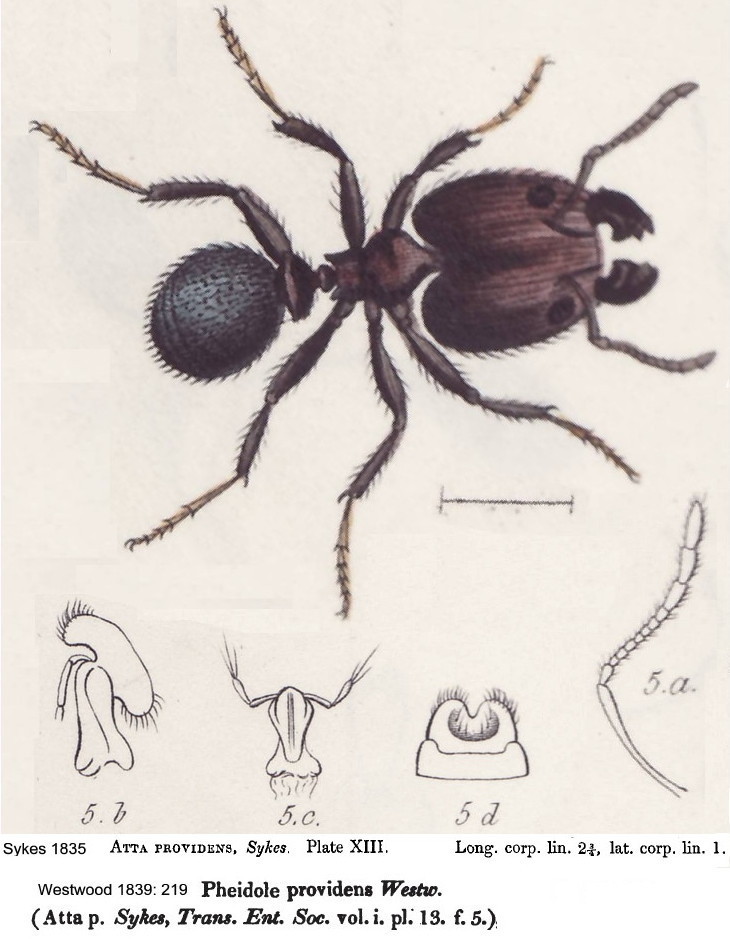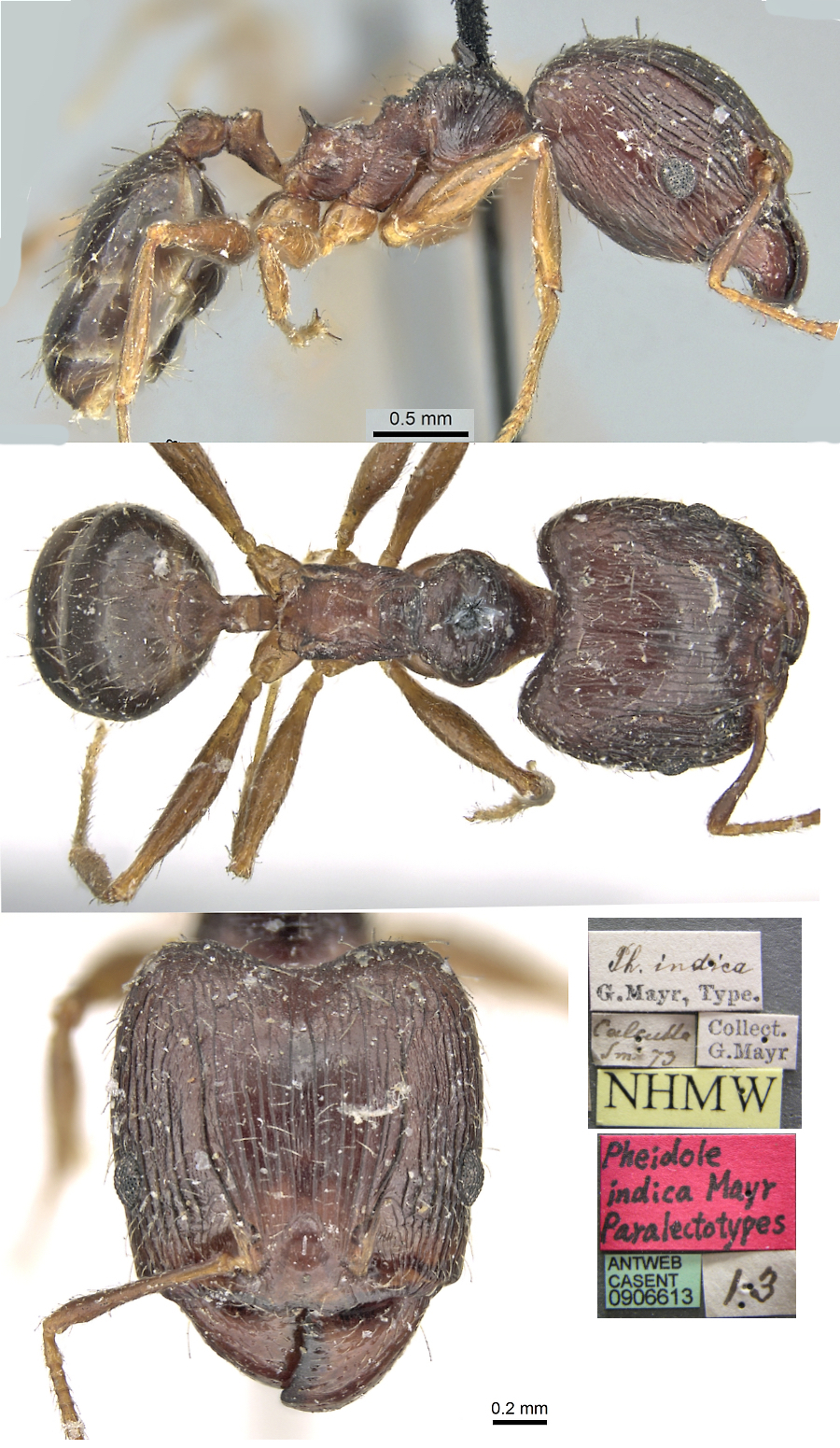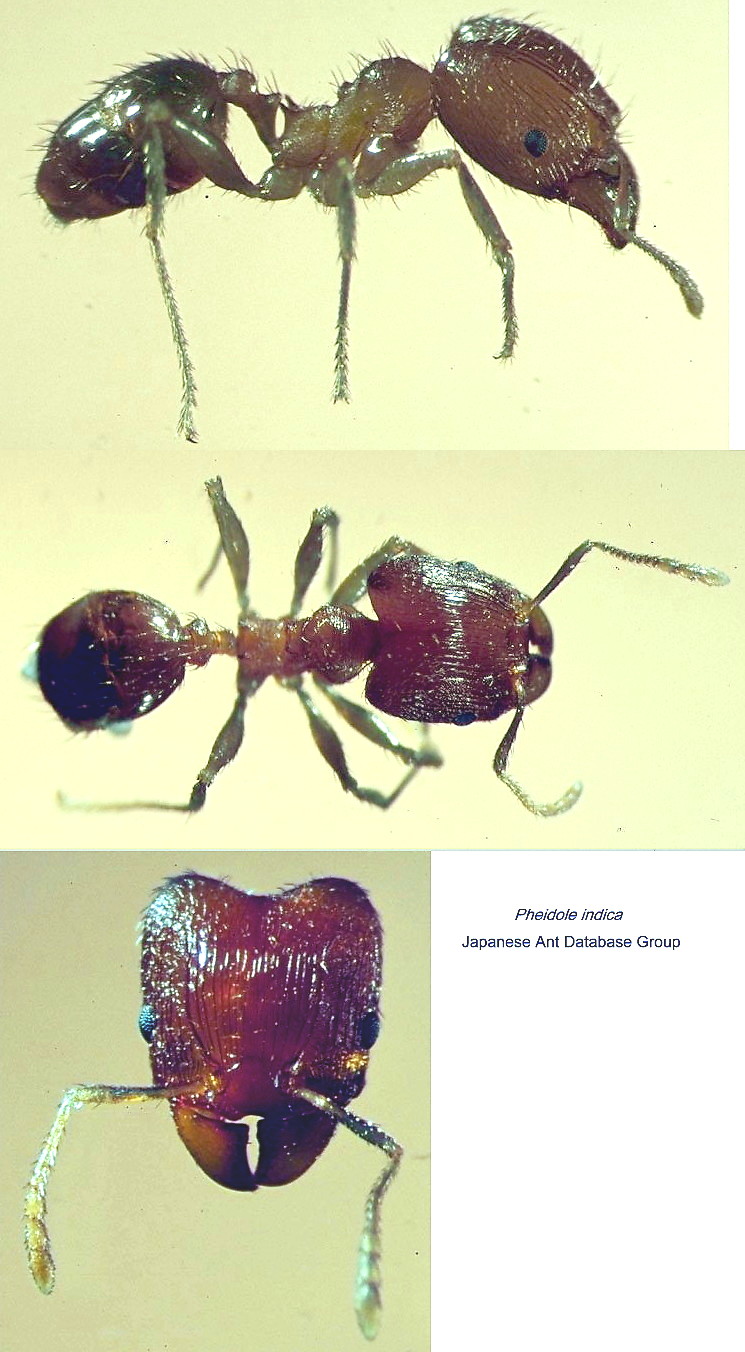Pheidole providens (Sykes) - majors

|
 Atta
providens Sykes 1835: 103, illustrated major worker, type location India,
Poona. Atta
providens Sykes 1835: 103, illustrated major worker, type location India,
Poona.
|
 The
photomontage
of a paralectotype major worker of indica is collated from http://www.antweb.org/specimen.do?name=casent0906613. The
photomontage
of a paralectotype major worker of indica is collated from http://www.antweb.org/specimen.do?name=casent0906613.
The designation as paralectotype was by Eguchi (2004: 198).
Note: All the fresh specimens shown below are a nearly exact match for this.
|
MAJOR - new description - TL ca 4.5, CI 90-93, SI
52-58, OI 16, PPW/HW 46-49. Head in full face view with near straight
sides, slightly diverging from front to back; with a deeply impressed
occiput; longitudinal striations reaching the occiput and often
strongly marked; with a distinct antennal scrobe that has weakly
spiculate base sculpture. In profile the head evenly is convex below,
but angular above; in full face view the vertex is distinctly impressed
The mandibles are smooth and shiny but with distinct minute hairs pits.
The clypeus also is smooth and shiny without a distinct median
longitudinal carina. The frontal carinae long and almost straight,
diverging relatively little after widening immediately behind the
antennal insertion; the carinae reach almost to the occiput and
apically turn forwards to create a shallow but distinct scrobes.
Antennae with both scapes and funiculi slender but moderately long
reaching back to the three-quarter point of the head; the antennal club
comprises three quite short, elongated bead-like segments. The eye is
quite small and near circular (10-11 facets long X 10 wide); set 1.5 X
its own length back from the lateral margin of the clypeus. Hypostoma
with no median tooth, moderately strong black submedian teeth and
moderately strong black lateral teeth. The underside of the head is
weakly striate, with a semicircular pattern anteriorly and shiny. The
alitrunk profile is irregular with a high domed pro-mesonotum; there is
a very distinct transverse welt on the mesonotum which angles downwards
posteriorly into a shallow but quite wide metanotal groove. The
propodeum profile is flat but slopes downwards from front to back, with
strong but narrow triangular teeth; from above it is distinctly
margined with a longitudinal impression that widens from front to back.
The petiole in profile has a fairly long peduncle which rises evenly
from the anterior to the top of the node; that is a moderately high
oblique triangle with the upper margin narrowly rounded and entire, the
posterior face is near vertical. The postpetiole is small and globular
in profile; from above it is more than twice as wide as the petiole and
has sharply conical lateral apices. The gaster is almost as large as
the head and evenly globular, without a distinct anterior margin.
Overall the erect pilosity is quite long, fine and abundant; on the
front of the head there is an abundance of thicker erect hairs; on the
gaster the hairs are shorter and even more abundant; the pubescence is
short, adpressed but quite sparse. The sculpturation on the anterior of
the head is of strong longitudinal striations with no reticulation, the
posterior of the head on the sides also is striated; the alitrunk,
apart from the pronotum dorsum which has fine curved transverse rugae,
has strong longitudinal striations overlying loose puncturation, the
dorsum of the propodeum is almost smooth. Overall the ant is quite
shiny, with the gaster very smooth and glossy. The general colour is
very variable from yellow-brown to red-brown even to near black, with
the gaster much the same colour. The funiculi, legs and mandibles are
uniformly lighter than the general colour.
|
 The photomontage
here is of a major worker from Egypt, Qaliobyia, collected
by Mostafa Sharaf, 2002. The photomontage
here is of a major worker from Egypt, Qaliobyia, collected
by Mostafa Sharaf, 2002.
|
 The
photomontage is of a major worker from Israel, Tel Aviv
Zoo, collected by Armin Ionescu; 20.iii.2007. The
photomontage is of a major worker from Israel, Tel Aviv
Zoo, collected by Armin Ionescu; 20.iii.2007.
|
 The
photomontage is of a major worker from Israel, Tel Aviv
University, Sherman, collected by Armin Ionescu; 20.iii.2007. The
photomontage is of a major worker from Israel, Tel Aviv
University, Sherman, collected by Armin Ionescu; 20.iii.2007.
|
 The
"Pheidole teneriffana" specimens we have from Qaliobyia Egypt,
and Tel Aviv, Israel, however, are a match for the Pheidole indica
specimens shown on
http://ant.edb.miyakyo-u.ac.jp/E/Taxo/F40603.html, where it is
separated from P. fervens, by the dark-coloured body, larger
eyes and upwardly directed propodeal spines in soldiers and workers The
"Pheidole teneriffana" specimens we have from Qaliobyia Egypt,
and Tel Aviv, Israel, however, are a match for the Pheidole indica
specimens shown on
http://ant.edb.miyakyo-u.ac.jp/E/Taxo/F40603.html, where it is
separated from P. fervens, by the dark-coloured body, larger
eyes and upwardly directed propodeal spines in soldiers and workers
|
|